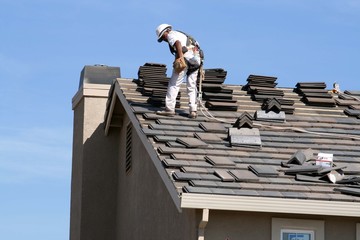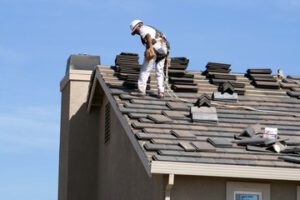Types of Residential Roofing

Residential roofing is an important investment for homeowners. The right roof system helps regulate indoor temperatures, protects against weather damage and other threats, and raises home curb appeal.
 There are many types of residential roofing materials, each with benefits and drawbacks. Asphalt shingles are popular for their affordability and ease of installation, while tile roofs offer an attractive aesthetic.
There are many types of residential roofing materials, each with benefits and drawbacks. Asphalt shingles are popular for their affordability and ease of installation, while tile roofs offer an attractive aesthetic.
Steep-sloped or pitched roofs are the most common roofing types found on homes and small business structures. They can be made of various materials, including asphalt shingles, metal, slate, wood shakes, natural or synthetic tile, clay, and concrete tiles.
A steep-sloped roof is defined as a roof with a slope (pitch) of 3:12 or greater, meaning for every 12 horizontal inches of a flat roof, it rises 3 vertical inches or more. Steep-sloped roofs can be constructed in a wide variety of styles. They can be accented with decorative caps, inventive designs, roofs, or other features to create dramatic and eye-catching rooflines that can make an architectural statement.
Efficient Shedding — Steep-sloped roofs are more efficient at shedding rainwater and snow than low-sloped roofs. This is because the water and snow naturally rolls or slide off the roof into gutters, rather than accumulating on the roof itself. This can help prevent mold & mildew growth, as well as extend the life of your roof. It is important to have the correct size of gutters installed on a steep-sloped roof, as too big or too small can cause overflowing and flooding problems.
Low Maintenance
Another advantage of steep-sloped roofs is that they are generally easier to maintain than low-sloped roofs. Since debris doesn’t linger on the roof, it is easy to remove and replace shingle tabs when needed, as well as to clean and clear away any standing water or snow that may have built up over time.
Visual Appeal — Because steep-sloped roofs can be so visually appealing, they are often seen as a key element of the overall look and design of a building. This is especially true for residential construction, where the roof can account for up to 40% of a home’s exterior.
Because they are easier to install, less expensive and more versatile than low-sloped roofs, steep-sloped roofs are an excellent choice for many homeowners and builders. However, they do require more attention and care than low-sloped roofs to ensure that they last as long as possible.
Materials
When it comes to roofing, many homeowners are faced with a number of options. The type of roof they choose can add to the beauty and value of their home or detract from it. Many of the choices come down to cost, the weather conditions of their area and personal preferences.
Rolled roofing material has long been a standard feature of low-sloped residential roofs and outbuildings like sheds, barns or garages. This type of roof is cheap, rugged and easy to install but it doesn’t offer much in the way of aesthetic appeal.
There are also many styles of shingles, shakes and slates that can be used on residential roofs. These materials are not only attractive and long-lasting but they also serve a critical function in protecting the building from water damage, debris and heat loss. There are also many energy-efficient shingles available that are designed to capture the sun’s power and generate electricity for the house.
Metal roofs are another common choice and can be found on everything from barns to high-rise apartments. These roofs are relatively lightweight, easy to install and come in a variety of colors and textures. They are also extremely durable and can resist moisture, wind and hail.
A more expensive option is a stone or tile roof. These roofs are often found on luxury homes and can last for 60 to 150 years or more. They are very durable and can withstand high winds, temperature fluctuations and hail.
Other roofing materials include concrete tiles and PVC or EPDM membranes. These types of roofs are typically used on flat or low-sloped commercial and residential buildings that require a durable waterproof membrane.
Another type of roof is a corrugated galvanized sheet metal. This form of metal roofing has long been a mainstay on agricultural and utility buildings, such as barns or sheds. This type of roofing is inexpensive, durable and easily installed in large expanses by simply soldering one sheet to its parallel mate along the seam. This method of installation also allows for the use of fewer fasteners, which can reduce leaks and other problems.
Installation
Choosing the right roof material is a personal choice that depends on the homeowner’s budget, climate and architectural style. Some roofing materials may be more expensive than others, but all will protect a house from the elements and add value to the property. Residential roofing contractors can offer expert advice on the different types of roofs and what might work best for a specific home.
The first step in residential roofing is to install the foundation of the roof, referred to as decking or sheathing. It is generally made of plywood or OSB, although older homes might have tongue and groove or narrow 1-by skip sheathing boards cut from framing lumber like 2x10s. If the roof is built on a wood frame, the rafters or trusses are then nailed to the decking with nails or screws. Then a layer of felt is applied to the sheathing, which acts as an underlayment for the shingles or other roofing material.
There are several options for the actual roof covering, with asphalt shingles being one of the most popular and affordable. They also offer a good level of protection from the sun’s rays, and they can last up to 20 years on average. Other types of roofing materials include metal, which offers a long lifespan and can be designed to suit specific architectural styles. Tile roofs are another option, offering a natural aesthetic and good heat or cold insulation. However, they are not suitable for all climates and require more maintenance than other roofing materials.
Other types of residential roofing include clay or concrete tiles, which are extremely durable and can last for decades. They can withstand extreme weather conditions and are available in a variety of colors and textures to complement any architectural design. Wood shakes, on the other hand, are a more rustic option that can offer a beautiful natural look and are ideal for certain climates. However, they are more likely to leak than other roofing materials, and they must be regularly inspected for damage and maintained. Both residential and commercial roofing need regular attention to maintain the structural integrity of the roof and prevent water leaks or other problems. For residential roofs, this includes routine cleaning and inspections for signs of damage. In addition, it is important to keep gutters clear of debris to prevent clogging and downspout blockages.
Maintenance
Residential roofs serve a very important function in the home. They protect the inhabitants of a building and their belongings from the elements, while also regulating indoor temperatures. As such, they require regular maintenance to keep them functioning well. One such activity is routine inspections, which can help identify and fix problems before they become more severe. Additionally, homeowners should make sure that their roofs are properly ventilated and insulated to prevent moisture buildup and to ensure proper water drainage.
The most common type of roofing material for residential properties is asphalt shingles. They are relatively affordable and provide excellent protection from the elements. They also come in a wide variety of colors and styles to match the aesthetic of a house. However, it is important to note that asphalt shingles tend to have a shorter lifespan than other types of roofing materials.
Other popular types of residential roofing include tile and metal roofs. These roofs offer a more unique look, but they can be more expensive to install and maintain than other roofing options. In addition, they may not be suitable for all climates.
Homeowners should always hire a professional roofing contractor to perform any roof maintenance or inspections. Attempting to repair or inspect a roof yourself can be dangerous, especially if it is a steep-sloped roof. In fact, falling from a roof is the number one cause of construction-related deaths.
In addition to conducting visual inspections, home and building owners should make sure that their gutters and downspouts are clear of debris. This will ensure that water drains properly and avoids ice damming. It is also a good idea to replace any damaged or missing shingles and to unblock any downspouts that may be blocked by debris.
A new roof can add to the curb appeal of a home and improve its overall value. It can also help to reduce energy costs and protect the occupants of the building from harmful UV rays. In addition, a new roof can protect the interior of a building and prevent mold, mildew, and other problems.

